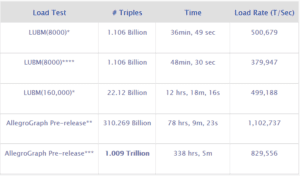AllegroGraph, a purpose built (not a modified RDBMS), NoSQL Graph Database continued to drive innovation in the marketplace with the 2008 SemTech conference example of 10 billion quads loaded on Amazon’s EC2 service. The new version 4 series continues to bring performance to the forefront of Franz’s Semantic Technologies as the industry’s first OLTP semantic web database. AllegroGraph’s ability to automatically manage all available hardware resources to maximize loading, indexing and query capabilities once again raises the bar for RDF storage performance. The following table displays examples of AllegroGraph’s performance in loading and indexing.

* 32 core Intel E5520, 2.0 GHz, with 1 TB RAM, Red Hat Enterprise Linux 6.1.
** 64 core Intel x7560, 2.27 GHz, 2TB RAM, 22TB Disk, Red Hat Enterprise Linux 6.1. LUBM-like data.
*** 240 core Intel x5650, 2.66GHz, 1.28TB RAM, 88TB Disk, Red Hat Enterprise Linux 6.1. LUBM-like data
**** 2 x 4 core Intel E5520, 2.26 GHz, 48GB RAM, CentOS 5.3
Dynamic Materialization
AllegroGraph’s RDFS++ engine dynamically maintains the ontological entailments required for reasoning: it has no explicit materialization phase. Materialization is the pre-computation and storage of inferred triples so that future queries run more efficiently. The central problem with materialization is its maintenance: changes to the triple-store’s ontology or facts usually change the set of inferred triples. In static materialization, any change in the store requires complete re-processing before new queries can run. AllegroGraph’s dynamic materialization simplifies store maintenance and reduces the time required between data changes and querying.
If you have questions or are interested in other benchmarks, please send email to info@franz.com.

